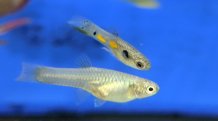
Male guppies are more colourful than females - credit Ben Toulson
Colourful male fish have genes to thank for their enduring looks
Striking traits seen only in males of some species – such as colourful peacock feathers or butterfly wings – are partly explained by gene behaviour, new research suggests.
The findings aid understanding of the phenomenon, which can help animals attract mates, but also make them more vulnerable to predators.
Researchers studied the genetics of Trinidadian guppies, whose males are brightly coloured compared with the dull brown of females.
Researchers at the Universities of Edinburgh and Exeter used fish bred in the lab to carry out detailed studies of how genes are passed on during reproduction.
Scientists compared genetic maps over several generations alongside entire genetic codes, to understand how genes were inherited over time.
In typical sexual reproduction, a set of genes from each parent would combine randomly to create offspring with a mix of features from both.
But in male guppies, packages of genes in cells – known as chromosomes – were found to exchange genes only from their tips.
Many genes, including those that cause bright colours, are passed on from one male generation to the next almost undisturbed, and rarely mix with genes inherited by females.
Researchers found that this low rate of genetic mixing between the sexes has enabled the evolution of the male’s brightly coloured appearance, by conserving the characteristic over many generations.
“One of the remarkable things about the results is that not only are male and females different morphologically, but differences can be observed at a genetic level, specifically in the way that genetic information is exchanged via crossing over within each sex,” said Dr Lengxob Yong, of the Centre for Ecology and Conversation on the University of Exeter’s Penryn Campus in Cornwall.
“And such sex differences in recombination rates can have important consequences on how males and females appear, and partly explain how sexual dimorphism evolves.”
Dr Roberta Bergero of the University of Edinburgh’s School of Biological Sciences, who co-led the study, said: “Insight into exchanges between male and female genes have helped explain how these bright colours have evolved and diversified in male guppies.”
Their study, supported by the European Research Council, is published in Proceedings of the National Academy of Sciences.
The paper is entitled: “Exaggerated heterochiasmy in a fish with sex-linked male coloration polymorphisms.”
Date: 22 March 2019
